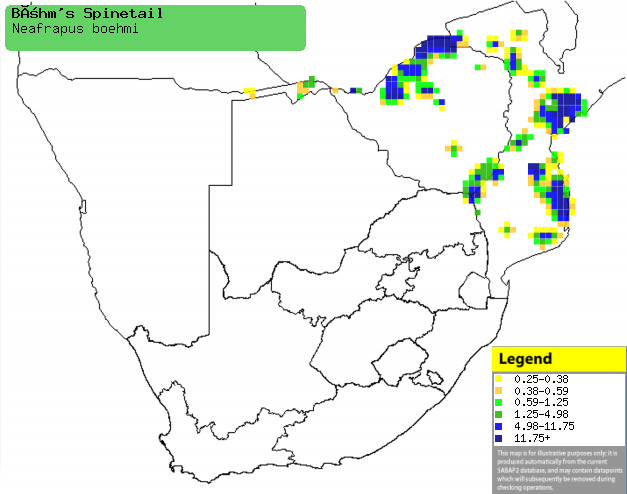|
Neafrapus boehmi (Böhm's
spinetail)
Witpensstekelstert [Afrikaans]; Sisampamema (generic term
for swallows, martins, swifts and spinetails) [Kwangali]; Böhm-gierzwaluw
[Dutch]; Martinet de Böhm [French]; Fledermaussegler [German]; Rabo-espinhoso
de Böhm [Portuguese]
Life
> Eukaryotes >
Opisthokonta
> Metazoa (animals) >
Bilateria >
Deuterostomia > Chordata >
Craniata > Vertebrata (vertebrates) > Gnathostomata (jawed
vertebrates) > Teleostomi (teleost fish) > Osteichthyes (bony fish) > Class:
Sarcopterygii (lobe-finned
fish) > Stegocephalia (terrestrial
vertebrates) > Tetrapoda
(four-legged vertebrates) > Reptiliomorpha > Amniota >
Reptilia (reptiles) >
Romeriida > Diapsida > Archosauromorpha > Archosauria >
Dinosauria
(dinosaurs) > Saurischia > Theropoda (bipedal predatory dinosaurs) >
Coelurosauria > Maniraptora > Aves (birds) > Order: Apodiformes >
Family: Apodidae
Distribution and habitat
Occurs from Kenya, through Tanzania, southern DRC,
Zambia and Angola to southern Africa. Within southern Africa it is generally localised and
uncommon in the Caprivi Strip (Namibia), northern and south-eastern Zimbabwe,
Mozambique and marginally in the Limpopo Province. It generally prefers edges and clearings of dense woodland,
especially miombo (Brachystegia) but also evergreen woodland and riverine
forest.
|
 |
|
Distribution of Böhm's
spinetail in southern Africa,
based on statistical smoothing of the records from first SA Bird Atlas
Project (©
Animal Demography unit, University of
Cape Town; smoothing by Birgit Erni and Francesca Little). Colours range
from dark blue (most common) through to yellow (least common).
See here for the latest distribution
from the SABAP2. |
Movements and migrations
Resident and largely sedentary, although it may
make local movements.
Food
It mainly eats insects, such as beetles and ant alates,
doing most of its foraging by hawking prey aerially. It often joins
mixed-species foraging flocks, typically flying low over the tree canopy.
Breeding
- Monogamous, solitary nester, with both sexes building a U-shaped structure
with a central cup, made of fine twigs and lined with feathers or wood
chips. It is typically placed in a Baobab (Adansonia digitata) or
on the vertical wall of a deep pit, well or mine shaft.
- Egg-laying season is from August-May, peaking from October-March.
- It lays 2-3 eggs, which are incubated by both sexes for about 17-20
days.
- The chicks leave the nest after about 38-42 days, although beforehand they move out to cling to the wall of the nesting cavity.
Threats
Status uncertain.
References
-
Hockey PAR, Dean WRJ and Ryan PG 2005. Roberts
- Birds of southern Africa, VIIth ed. The Trustees of the John Voelcker
Bird Book Fund, Cape Town.
|
